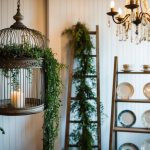Essential Home Decor Tips for Creating a Cozy and Inviting Living Room: Expert Advice for a Welcoming Space
Accentuating with Wall Decor
Choosing the right wall decor can dramatically enhance the appeal of a living room. Mirrors and artwork are two vital elements that add personality and depth to the space.
Mirrors to Expand Spaces
Mirrors are a powerful tool in interior design. By reflecting light, they can make a room appear larger and more open. Placing a large mirror opposite a window can enhance natural light, creating a bright and welcoming atmosphere.
Mirrors come in various shapes and sizes, and the chosen style should align with the room’s theme. Ornate frames work well in traditional settings, while sleek designs fit modern aesthetics. Positioning mirrors at eye level is key for functionality and visual impact.
Additionally, mirrored wall panels or a series of small mirrors can add texture and interest. Experimenting with arrangement can lead to unique and captivating results.
Art Selection and Placement
Selecting art involves considering the room’s color palette and the emotions you wish to evoke. Opt for pieces that complement or contrast with the existing decor. Bold, vibrant art can create a focal point, while subtle pieces add sophistication.
The placement of art is equally important. Centering a large painting above a sofa or mantel creates balance. For multiple pieces, grouping them in a gallery wall can provide an artistic and cohesive look.
Proper spacing between pieces prevents a cluttered appearance. Using level tools ensures that artwork is hung straight, enhancing the room’s symmetrical beauty. Custom framing can also add an elegant touch, aligning art with the room’s overall design scheme.
Layering Textures and Patterns
Creating a cozy and inviting living room involves mixing various textures and patterns to add depth and interest to your space. Focus on combining different fabric types and balancing patterns effectively.
Mixing Fabric Types
Incorporating a variety of fabric types can bring richness and warmth to a living room. Think about using cotton, linen, velvet, and wool across furniture, pillows, and throws.
For example, a linen sofa can be complemented with velvet cushions and a wool throw. Small elements, like a silk lampshade or a jute rug, can also make a significant difference.
Choose fabrics that vary in texture but harmonize in color. Pairing smooth materials with rough ones, like a sleek leather ottoman with a chunky knit blanket, creates visual interest without overwhelming the space.
Balancing Patterns
Patterns can energize a room when balanced correctly. Stick to a consistent color scheme to ensure different patterns work well together. Combining florals, stripes, and geometrics in varying scales keeps the look cohesive.
For instance, a large floral rug pairs well with smaller striped throw pillows. Avoid matching sets; instead, aim for complementary patterns.
Using neutral backgrounds can help patterns stand out without clashing. A patterned armchair can become a focal point when surrounded by solid color pieces. Consider the room’s function and choose patterns that enhance its atmosphere, such as cheery prints for lively rooms or soft patterns for a calming space.
Lighting as a Design Element
Lighting plays a crucial role in transforming a living room into a cozy and inviting space. It requires a blend of practicality and aesthetic appeal to achieve the perfect ambiance.
Choosing Statement Lighting
Statement lighting fixtures can serve as a focal point in a living room. Chandeliers, pendant lights, and floor lamps not only illuminate the space but also add a touch of elegance and style. When selecting a statement piece, it is essential to consider the room’s size and existing decor.
A well-chosen chandelier can draw attention upward, making the room appear taller and more spacious. Pendant lights can be strategically placed over coffee tables or seating areas to create intimate illuminated spots. Floor lamps, especially those with adjustable arms, provide flexibility in directing light where it’s needed.
Lighting fixtures should complement the room’s color scheme and furniture style. A modern living room might benefit from sleek metal or glass fixtures, whereas a more traditional space may welcome ornate or vintage styles. The goal is to harmonize the lighting with the rest of the decor, ensuring that it is both functional and visually appealing.
Candlelight and Ambient Glow
Candles offer a soft, warm glow that enhances the cozy atmosphere of a living room. They can be used on coffee tables, shelves, or window sills to create a serene and inviting ambience. Scented candles add a layer of fragrance that can boost the room’s overall comfort.
Besides candles, incorporating ambient lighting through dimmable bulbs and lampshades helps in setting the mood. Floor lamps with dimmer switches or lampshades that diffuse light evenly create a gentle, soothing environment. String lights, placed around window frames or shelves, add a whimsical touch without overpowering the space.
It is important to balance different light sources to avoid too much brightness or shadow. Multiple smaller light sources can be used together to create a layered lighting effect. This balance ensures that the living room remains welcoming and functional at any time of day or night.



